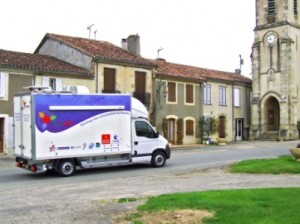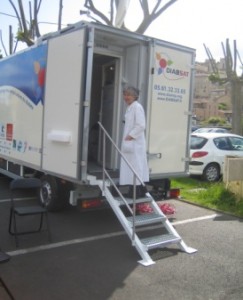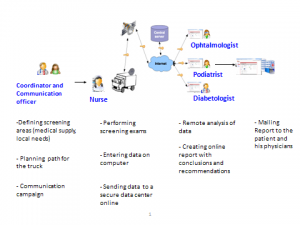Momentum telemedicine service descriptions
DIABSAT (FR)
Objectives, expected outcomes, main beneficiaries

A Diabsat truck in rural France
Diabsat is a telemonitoring service for people with diabetes using mobile screening. The aim is to improve medical monitoring of people with diabetes near their home. The service uses a mobile truck with medical equipment. It works primarily in rural areas with a dearth of health service providers so that the recommendations of the French Health Authority for annual screenings can be met. In the short term the expected outcomes included tested and more robust technology and increased familiarity among people with diabetes and healthcare providers with the use and potential of remote monitoring. In the future healthcare services may also be re-organised. In the long term there is hope of a reduction in complications of patients experiencing diabetes as well as cost savings. The main beneficiaries of the service are people with diabetes who live in rural areas who may be facing difficulties in identifying and consulting specialist physicians including diabetologists, podiatrists or ophthalmologists.
Targeted population, number of patients
The target population is people with diabetes living in remote areas. In France about 2.2 million people (four percent of the population) have been diagnosed with diabetes, of whom 92 percent are type 2 diabetic. Of those, about 400,000 people are estimated to live in France’s rural areas: this is the number of eventual potential beneficiaries of the service. Currently, the service is deployed in Midi-Pyrénées region in which the type 2 diabetic population is estimated to be 92,000. Other French regions are interested in developing this service on their area and partnerships are being built to transfer technology and know-how.
Type of telemedicine service
Nurses in a mobile truck tour rural France to perform screenings on selected patients. They enter the screening results in the patient record (including the fundus graph that shows the width of the retinal eye vessels, and the foot print graph). Then they transfer the data via satellite to a secure online data centre. From their offices, medical specialists (diabetologists, ophtalmologists and podiatrists) access and analyse the results and prepare a report online which contains their interpretation, diagnosis and care recommendations. The reports are mailed to the patients and their physicians. The service was initially made available for diabetic patients informed by the mayor, pharmacy, their nurse or doctor in rural areas, as part of a broad campaign of communication. Thereafter, the service was requested by groups of physicians, multidisciplinary home health, nursing homes for patients in rural areas. A recent campaign was also conducted in some urban areas in precarious populations.
Set-up that was being replaced
The purpose of this service was not to replace a conventional treatment. Rather, it was to reinforce medical monitoring for people with diabetes by supporting general physicians in rural areas where the supply of medical specialists (especially diabetologists, ophtalmologists, podiatrists) is dwindling. Patients face difficulties in seeing specialists at recommended annual intervals either because of long distances or waits for appointments. They may not be aware of the need for annual medical exams so as to avoid further complications in their diabetes.
Outcomes and results expected after introduction
The service trial (from 2010 to 2013):
- Established good technical feasibility of mobile screening:
- good data flow and low cost of internet with new satellite technology
- average time between screening and mailing report : ~15 days
- Improved medical monitoring of diabetic complications for people with diabetes
- 1,545 screened patients
- 228 days of screenings
- Screening results: 50.7 percent of patients were diagnosed with at least one complication:
- 48.6 percent of eye screening test performed and interpreted, 18.7% pathological
- 53.1 percent of renal screening test performed, 32.0% pathological
- 86.2 percent peripheral artery screening test performed, 17.2% pathological
- 93.2 percent foot sensitivity screening tests performed, 28.3% pathological
- 93.0 percent assessment of foot wound risk by grading: 66.7% low risk (grade 0 or 1); 26.2% high risk (grade 2 or 3)
- Better sensitisation of people with diabetes and their physicians about medical monitoring of diabetes’ complications.
- A high degree of satisfaction:
- 75 percent of patients’ returned their questionnaire; with regional variations, between 92 and 100 percent of respondents considered the screening useful, relatively painless and fast.
- Depending on the area, between 6 to 18 percent of physicians returned their questionnaire; they found screening campaigns useful to educate patients about the need for annual screenings to detect complications (particularly eye and foot complications). Between 44 and 75 percent of respondents considered the time between screening and receiving the report “fast”.
- Improved organisation of care following the screening tests and reduced health care costs. (The trial is awaiting the data analysis from the National Health Insurance Agency.)
Detailed description
The DIABSAT 2 (Diabetology satellite assisted) program integrates the following devices:
There are specific screening devices, medical furniture (hospital bed, table, chairs, washbasin, etc.), computers and a connected satellite antenna.
The nurses welcome patients and interview them to collect administrative, socioeconomic and medical data. Then they ask the patients about their annual medical follow-up. If the patient had not had one or more of the recommended examinations, they perform the screening tests to detect ophthalmic or renal or neurological or foot infections which are specific to diabetes.
The retinograph collects images of fundus (the width of the retinal eye vessels), and a device for semi-quantitative measure of microalbuminuria detects a loss in renal function .
The nurses also perform clinical examination of the patient’s legs and feet. They looks for potential loss of foot sensivity (monofilament test), peripheral artery disease (measure of Systolic Pressure Index) and risks of foot ulcer (foot prints record).
Operational status
The service has been running for four years. The trial lasted from 2010 to 2011. Since 2012, this service has been funded by the regional network in diabetes care (DIAMIP) and by the University Hospital of Toulouse. We are still looking for sustainable funding to carry on the telemonitored screening campaigns. Partnerships have been launched in various regions of France and overseas departments (départements outre-mer) to deploy the service.
Further information
Or contact Dr Jacques Martini (MD), Diabetologist, president of the regional network for diabetes care (DIAMIP), at Martini.j@chu-toulouse.fr.





